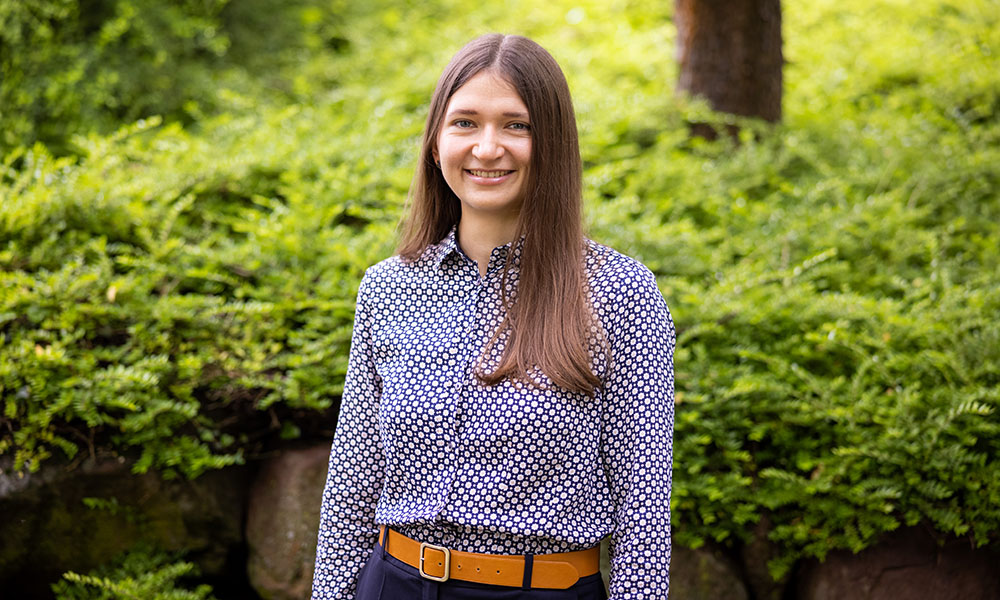
Welcome: Maria Zimmermann-Kogadeeva
‘Following her gut’ led this computational biologist and one of EMBL’s newest group leaders to study the metabolic potential of the bacterial community in the gut.

Maria Zimmermann-Kogadeeva got her first ‘taste’ for computational science in high school when she learned to code. Today she is one of EMBL’s newest group leaders. She applies computational modelling to better understand the metabolism of gut bacteria and their potential impacts on other organs. Here, she shares a bit about her research group’s work, why EMBL’s multidisciplinary environment suits this research, and how sometimes the best advice is to – ahem – follow your gut.
1. Tell me a little bit about your research.
I am investigating the metabolic interactions between gut microbes, their environment, and their host.
Metabolism is central to life. This is how cells generate energy and biomass from the nutrients they consume from the environment. Bacteria in our gut can adapt their metabolism to survive very different nutrient and stress conditions, such as periods of feast and famine, oxygen gradients, and the host immune response. Metabolites – small molecules that are generated when organisms process nutrients – can also be seen as the chemical language of interactions between different cells. Metabolic interactions between microbes and the host affect host health and disease, as bacterial-produced metabolites can reach other organs, including the liver and brain. Gut bacteria are genetically diverse and collectively encode about a hundred times as many genes as the human genome. However, the function of at least a third of those genes (some of which might be involved in metabolism) remains unknown.
In my lab, we are investigating the unknown metabolic potential of gut bacteria. However, even if we understand every single bacteria’s metabolism, they might behave differently in a bacterial community. Inside the host, this is yet another level of complexity. We are developing and applying computational and experimental approaches to tackle at least some aspects of this complexity.
2. Have you always combined both computational and experimental approaches in your research?
I started as a computational scientist. I started learning programming in high school and quickly got fascinated creating code that automated computational tasks, built games, simulated movements of planets and satellites, and could identify patterns in biological and medical data. I studied mathematics and computer science at university, focusing on machine learning, and learned how machines can help foresee earthquakes, recognise what is captured in a photograph, or predict customer behaviour in retail chains. Most of all, I was attracted to bioinformatics and life science applications, such as protein structure prediction, analysis of molecular features and their interactions, and genotype-phenotype associations. For my PhD studies, I knew I wanted to move to an interdisciplinary wet lab and have the possibility of generating the data myself. I think it is very important for computational biologists to know where the data comes from and how it is generated.
3. How much does your research affect what you personally eat or the medicines you take?
Not much, to be honest. I try to avoid antibiotics unless they are absolutely necessary, and, like my microbiome, I enjoy eating fruits and vegetables. I also really like kefir and kombucha, but I developed the taste for them long before I started working on the microbiome. Knowing that they might be good for the microbiome makes me feel even better when I drink them.
4. What is your favourite pastime after a hard work week?
My favourite way to clear my head is with some physical activity, preferably outdoors – going for a walk, run, or bike ride in the forest or along the river. I also like swimming; unfortunately, the outdoor pools are closed in winter in Heidelberg. Dancing is a good way to move, clear your head, and have fun. I wish I was doing more of all these!
5. What book would you recommend to others?
The popular science book, I contain multitudes by Ed Yong, is a beautifully written book about microbes in and around us – and not only us. For example, from this book I learned that the tsetse fly gives birth to one living larvae at a time, which it feeds with a substance similar to breastmilk. And of course, in this process, it transmits symbiotic microbes to its offspring that are important for them to survive the first few weeks of life!
6. What is the best career advice you have received?
When making an important decision, such as choosing your next career step, it helps to write down all the pros and cons of different options. But, in the end, you should follow your…gut.
7. You’ve actually already been at EMBL as a postdoc in the Bork group, so do you have a favourite place to visit here in Heidelberg that always brings you joy?
I really like the bridge over the Neckar Dam (Wehrsteg Wieblingen). In one direction, you see the city, and in the other, river banks and forest. It is very soothing to walk over the bridge and then take a stroll down the river.
8. Why is EMBL the right place for your research?
EMBL is interdisciplinary, multicultural, inclusive – all of this is essential for modern life sciences. My group’s research greatly benefits from collaborations with experimental and computational scientists across disciplines and technologies. I’m also fascinated by novel techniques I haven’t worked with before, such as stability proteomics, spatial multi-omics, single-molecule techniques, cryo-EM and super-resolution imaging. I would love to explore more ‘unusual’ collaborations, which is notably easy to do at EMBL, as the ‘collaborative spirit’ is at heart of EMBL research.


